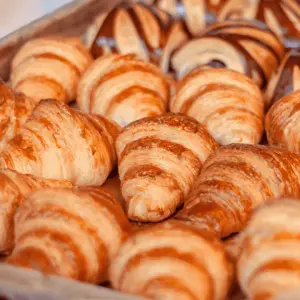Attention, food lovers! Have you ever heard of Gipfeli, the iconic Swiss pastry that has captured the hearts of many? These crescent-shaped delights are a staple in Swiss bakeries and a beloved breakfast treat. Imagine biting into a perfectly flaky, buttery Gipfeli, with its delicate layers and subtle sweetness. Intrigued? While often compared to croissants, Gipfeli have their own unique charm and cultural significance. In this article, we’ll dive into the world of Gipfeli and guide you through the process of making them at home with our delightful Gipfeli recipe. Desire to learn more? Let’s embark on this delightful culinary journey together!

History and Origins of Gipfeli
Gipfeli, also known as Swiss croissants, have a rich history that dates back to the 19th century. It is believed that the recipe was inspired by the Austrian kipferl, which was brought to Switzerland by Austrian bakers. Over time, Swiss bakers adapted the recipe to suit local tastes and ingredients, giving birth to the Gipfeli we know and love today.
In Switzerland, Gipfeli hold a special place in the culinary culture. They are a beloved breakfast pastry, often enjoyed with a cup of coffee or hot chocolate. Gipfeli are also a common sight in Swiss bakeries, where they are freshly baked every morning. Regional variations exist within Switzerland, with some areas preferring slightly sweeter or more buttery versions of the pastry.
Preparing Gipfeli Recipe at Home
Gipfeli Recipe Ingredients and Equipment
To make authentic Gipfeli at home, you’ll need the following ingredients:
– 500g all-purpose flour
– 10g instant yeast
– 10g salt
– 50g sugar
– 300ml milk
– 250g unsalted butter, cold
– 1 egg, beaten (for egg wash)
In terms of equipment, you’ll need:
– Stand mixer with dough hook attachment
– Rolling pin
– Sharp knife or pizza cutter
– Baking sheets
– Parchment paper
– Pastry brush
Step-by-Step Gipfeli Recipe Guide
- Activating the yeast and preparing the dough:
– In a stand mixer bowl, combine the flour, instant yeast, salt, and sugar.
– Gradually add the milk while mixing on low speed until a soft dough forms.
– Knead the dough for 5-7 minutes until smooth and elastic.
– Place the dough in a greased bowl, cover, and let it rise for 1 hour or until doubled in size.
- First rise and preparation of the butter layer:
– Punch down the risen dough and shape it into a rectangle.
– Cover and refrigerate for 30 minutes to chill the dough.
– Meanwhile, place the cold butter between two sheets of parchment paper and roll it into a thin rectangle.
– Refrigerate the butter layer until ready to use.
- Laminating the dough and forming layers:
– Roll out the chilled dough into a larger rectangle.
– Place the butter layer on top of the dough, covering 2/3 of the surface.
– Fold the unbuttered portion of the dough over the butter, then fold the remaining 1/3 over the top.
– Turn the dough 90 degrees and roll it out into a rectangle again.
– Fold the dough into thirds, like a letter. This completes one turn.
– Wrap the dough and refrigerate for 30 minutes.
– Repeat the rolling, folding, and chilling process two more times for a total of three turns.
- Shaping the Gipfeli:
– Roll out the laminated dough into a large rectangle, about 5mm thick.
– Using a sharp knife or pizza cutter, cut the dough into triangles.
– Roll up each triangle, starting from the wide end, to form a crescent shape.
– Place the shaped Gipfeli on a baking sheet lined with parchment paper.
- Second rise and proofing:
– Cover the shaped Gipfeli and let them rise for 30-45 minutes until slightly puffy.
– Preheat the oven to 200°C (400°F) during the proofing time.
- Baking to perfection:
– Brush the proofed Gipfeli with beaten egg for a golden-brown finish.
– Bake the Gipfeli for 15-20 minutes until puffed up and golden-brown.
– Remove from the oven and let them cool slightly before serving.
Troubleshooting Common Issues
– Dough shrinking back: If the dough shrinks back while rolling, let it rest for a few minutes to relax the gluten before continuing.
– Butter seeping out during baking: Ensure that the butter layer is evenly distributed and the dough is properly sealed during lamination. Chill the shaped Gipfeli before baking to prevent butter leakage.
– Achieving the perfect rise: Ensure that the yeast is active and the dough is given enough time to rise. Proof the shaped Gipfeli in a warm, draft-free environment for optimal results.
Enhancing the Gipfeli Recipe Experience
Variations of Gipfeli
While classic Gipfeli are delicious on their own, you can also explore various fillings to add an extra layer of flavor:
– Sweet fillings: Chocolate, almond paste, or fruit preserves can be added to the wide end of the triangle before rolling.
– Savory fillings: Experiment with savory options like grated cheese, diced ham, or herbs for a twist on the traditional Gipfeli.
– Alternative dough flavors: Infuse the dough with lemon zest, vanilla extract, or ground cinnamon for a subtle flavor enhancement.
Serving and Storage Tips
– Serving: Gipfeli are best enjoyed fresh out of the oven, while they are still warm and crispy. They pair perfectly with a cup of coffee or hot chocolate for a satisfying breakfast or snack.
– Storing: If you have leftover Gipfeli, store them in an airtight container at room temperature for up to 2 days. To refresh them, warm them up in the oven for a few minutes before serving.
– Reheating: To reheat Gipfeli, place them in a preheated oven at 180°C (350°F) for 5-7 minutes until warmed through and slightly crispy.
Gipfeli Recipe Health Considerations
While Gipfeli are an indulgent treat, it’s important to enjoy them in moderation as part of a balanced diet. One Gipfeli typically contains around 250-300 calories and is high in butter and refined flour.
To make Gipfeli a bit healthier, consider using whole wheat flour for a portion of the all-purpose flour. You can also reduce the sugar content slightly or opt for natural sweeteners like honey or maple syrup.
Remember, Gipfeli are meant to be savored occasionally as a special treat rather than consumed on a daily basis.
FAQs and Additional Tips
Frequently Asked Questions
- What makes Gipfeli different from croissants?
– Gipfeli are typically smaller and denser than croissants. They also have a slightly different shape, with tapered ends and a more pronounced crescent.
- Can Gipfeli dough be made ahead of time?
– Yes, you can prepare the dough up to the lamination stage and refrigerate it overnight. The next day, let the dough come to room temperature before shaping and baking.
- How to ensure Gipfeli are light and flaky?
– Proper lamination is key to achieving light and flaky Gipfeli. Make sure the butter layer is evenly distributed and the dough is rolled and folded correctly during the turning process.
- What are some common mistakes to avoid?
– Overworking the dough can lead to tough Gipfeli. Be gentle when rolling and folding the dough.
– Using warm or soft butter can cause it to melt into the dough, resulting in a greasy texture. Always use cold butter for lamination.
– Rushing the rising and proofing process can result in dense and heavy Gipfeli. Allow sufficient time for the dough to rise and proof properly.
Conclusion
Congratulations! You now have the knowledge and tools to create authentic Swiss Gipfeli in the comfort of your own home. Remember the key steps: preparing a smooth dough, laminating with cold butter, shaping into crescents, and baking to perfection. While the process may seem daunting at first, with practice and patience, you’ll soon be enjoying freshly baked Gipfeli that rival those found in Swiss bakeries.
Don’t be afraid to experiment with different fillings and flavors to make your Gipfeli truly unique. Share your creations with friends and family, and savor the satisfaction of mastering this beloved Swiss pastry.
We’d love to hear about your Gipfeli-making adventures! Share your photos, tips, and experiences in the comments below. Happy baking, and enjoy your delightful Gipfeli recipe!

